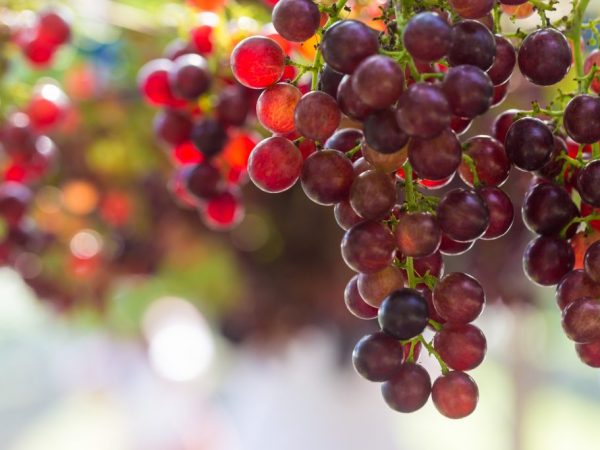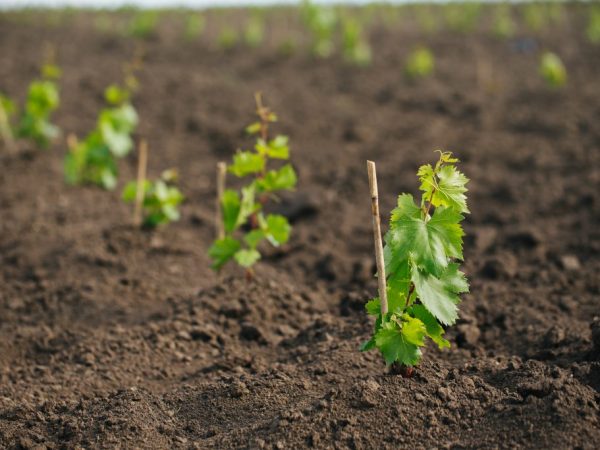Description of Crimson grapes
Juicy Crimson grapes - the result of crossing the Charrel and Voskovaya varieties. Resistant to low temperature conditions.

Description of Crimson grapes
Characteristics of grapes
Crimson grapes ripen early. The growing season lasts only 90-100 days. Harvesting begins in August. If Crimson is grown in northern regions with short and cool summers, the first fruits will appear in late August - early September.
The main advantage of the variety is its high yield level. Up to 8 kg of berries are harvested from one medium bush.
Crimson - cold-resistant plant. Withstands temperature drops down to -23 ° С. But despite this, it is better to protect the bush for wintering.
Description of the bush
According to the description, the Crimson grape variety is distinguished by a vigorous bush. The peak of growth is the first 2-3 years after planting. Plant height reaches a maximum of 3 m. Flowers are bisexual. Pollination is uniform.
Features of the bush:
- shoots are strong, long;
- raids ripen along their entire length;
- the bush takes root well;
- the vine ripens 2/3 of its length.
Sometimes raids of the second order appear, which are better to be removed once a season. They take all the juice, nutrients, which is why the plant cannot develop normally.
The bunches are strong. One can contain up to 100 berries. Able to withstand up to 2-3 brushes on 1 vine. One bunch weighs 600-800 g, sometimes 1 kg.
Description of fruits
The berries are large. The weight of one reaches 10-12 g. They have a light purple color, from the sunny side - yellow. The shape of the berries is oval, elongated, rounded at the end.
Pulp description:
- juicy;
- transparent;
- easily separated from the seeds.
The peel is thin, but does not burst under the influence of the sun and heat. Thanks to this, the berries lend themselves to long-term transportation. In a cold place, they retain their presentation for about a month.
According to the description, the taste is sweet, sometimes with sourness (depending on the place of cultivation). Crimson grapes are used for juices, homemade sweet wine. In combination with other berries and fruits, it is suitable for making marshmallows, jams, raisins. It is often added to cold summer salads, desserts and baked goods.
Growing grapes

The variety can be grown in any territory
Because grapes of this variety are grown in any territory, there are no special planting requirements. The main thing is to regularly inspect the bush.
Landing in the soil
When choosing a seedling, the root system and the condition of the shoots are examined. They should not be dry and waterlogged. It is necessary that the root system is well developed.
The landing site is chosen according to the following criteria:
- good lighting - the bush will stay in the shade for a maximum of 1 hour during the day;
- lack of large fruit trees nearby;
- no drafts and strong gusts of wind;
- groundwater is at a level less than 1 m.
Plant care
Caring for this type of grape consists of the following procedures:
- garter;
- trimming;
- fertilization;
- watering.
Garter
It is carried out to form a bush. It is carried out in 2 stages. The first is a dry garter.It is done in early spring, when the buds have not yet blossomed. A wire is attached to the lower part of the bush. Make different bends to make nutrients more accessible.
The second stage is the green garter. It is done in the first year after the tree reaches 40-50 cm in height. Young vines are fixed on the trellis at a slight angle. The procedure is carried out for good access to sunlight and protection from wind gusts.
Pruning
Pruning is carried out to rejuvenate and heal the bush. Dry, frozen branches, bunches that do not bear fruit are removed. There are 3 types of trimming:
- Spring circumcision. It is carried out after frost, when the temperature at night exceeds 5 ° C. Usually, damaged shoots or extra raids of the second order are removed.
- Summer. Extra branches are broken, the leaves are removed, blocking the light to the berries. This is necessary to provide the bush with light and normal ventilation.
- In the autumn. First, the bunches and shoots with fruits and those that did not bear fruit are removed. The second stage of pruning occurs after the foliage has dropped.
Fertilizer
Top dressing is applied 3 times - in spring, summer and autumn. The first and third are required, the second is optional. In the spring they focus on mineral fertilizers, in the fall - on organic, in the summer - on complex fertilizers.
The main stages of dressing:
- After wintering and frost. Dry fertilizers are applied around the trunk. Ingredients: 35 g of potassium, 45 g of superphosphate, 50 g of nitrogen. This is enough to feed 1 medium bush. Watering is not carried out. Only sprinkle with earth on top.
- Before flowering. Take manure and chicken droppings. Dilute them in 2 buckets of warm water, bringing them to a slurry consistency. The container is tightly closed and allowed to brew for at least 6-7 days. After that, the slurry is diluted in water in a ratio of 1: 6. Optionally add 30 g of potassium and 40 g of superphosphate. Consumption rate - 1 bucket of solution per 1 bush.
- After flowering (early ripening). They make potassium-phosphorus fertilizing. Take 55 g of superphosphate and 25 g of potassium. Diluted in a bucket of water. Introduce under 1 bush.
Watering
Watering is carried out at least 3 times. The watering time coincides with the feeding time. For each watering you need 3-4 buckets of water.
Features of the procedure:
- watered early in the morning or late in the evening (the sun must go down);
- take only warm or heated water;
- drip irrigation is carried out every 2 weeks to moisten the entire bush.
Diseases and pests
Crimson is resistant to disease. Resistant to mildew, mildew and bacterial cancer. If proper care is not followed, it is affected only by gray rot. Fungicides Antracol, Kuproksat, Ridomil, Strobi, Thanos, Horus will help in the fight against it. Their feature is not harmful to human health.
The main pest of Crimson is bees. Because of them, the berries lose their juiciness and quickly deteriorate. Liquid smoke is used to fight. The bees are afraid of him, and will no longer climb to the grapes.
Conclusion
Crimson - juicy and sweet grapes. It is grown throughout the territory of Russia. The fruits are consumed fresh and processed. Care consists of watering, dressing, garter and pruning.


